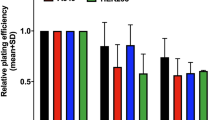Abstract
The aim of the present study is to evaluate the role of ATM (KU55933) and DNA-PK (NU7441) inhibitors in the repair of double-strand breaks and downstream signaling of DNA damage introduced by ionizing radiation. The irradiation of MCF-7 cells alone increased the proportion of cells in the G1 phase in comparison with mock-treated cells. After ATM inhibitor pretreatment, the cells were more accumulated in the G2 phase, whereas DNA-PK inhibitor application increased the percentage of cells in the G1 phase. ATM and DNA-PK inhibitor application alone increased the sensitivity of MCF-7 cells to ionizing radiation; however, combining both inhibitors together resulted in a further enhancement of cell death. Unexpectedly, combining both inhibitors decreased the percentage of senescent cells and increased G2 cell cycle arrest 3 days after treatment. After irradiation, the p21 protein was increased and Chk1 and Chk2 were activated. These proteins were not increased in cells pretreated with the ATM inhibitor prior to ionizing radiation exposure, albeit DNA-PK inhibitor application did not affect the amount of proteins detected. Formation of γH2AX was found to be ATM and DNA-PK dependent, application of the ATM inhibitor suppressed incidence of γH2AX, whereas DNA-PK caused persistence of γH2AX. Our results suggest that the further investigation of the ATM inhibitor in combination with the DNA-PK inhibitor as sensitizers preventing cell senescence and promoting cell death in breast carcinoma MCF-7 cells is warranted.




Similar content being viewed by others
References
An J, Huang YC, Xu QZ, Zhou LJ, Shang ZF, Huang B, Wang Y, Liu XD, Wu DC, Zhou PK. DNA-PKcs plays a dominant role in the regulation of H2AX phosphorylation in response to DNA damage and cell cycle progression. BMC Mol Biol. 2010;11:18.
Stiff T, O’Driscoll M, Rief N, Iwabuchi K, Löbrich M, Jeggo PA. ATM and DNA-PK function redundantly to phosphorylate H2AX after exposure to ionizing radiation. Cancer Res. 2004;64:2390–6.
Mukherjee B, Kessinger C, Kobayashi J, Chen BPC, Chen DJ, Chatterjee A, Burma S. DNA-PK phosphorylates histone H2AX during apoptotic DNA fragmentation in mammalian cells. DNA Repair. 2006;5:575–90.
Shiloh Y. ATM and related protein kinases: safeguarding genome integrity. Nat Rev Cancer. 2003;3:155–68.
Hill R, Lee PWK. The DNA-dependent protein kinase (DNA-PK): More than just a case of making ends meet? Cell Cycle. 2010;9:3460–9.
Cmielova J, Havelek R, Kohlerova R, Soukup T, Bruckova L, Suchanek J, Vavrova J, Mokry J, Rezacova M. The effect of ATM kinase inhibition on the initial response of human dental pulp and periodontal ligament mesenchymal stem cells to ionizing radiation. Int J Radiat Biol. 2013;89:501–11.
Davalos AR, Kawahara M, Malhotra GK, Schaum N, Huang J, Ved U, Beausejour CM, Coppe JP, Rodier F, Campisi J. P53-dependent release of Alarmin HMGB1 is a central mediator of senescent phenotypes. J Cell Biol. 2013;201:613–29.
Lossaint G, Besnard E, Fisher D, Piette J, Dulić V. Chk1 is dispensable for G2 arrest in response to sustained DNA damage when the ATM/p53/p21 pathway is functional. Oncogene. 2011;30:4261–74.
Siles E, Villalobos M, Valenzuela MT, Núňez MI, Gordon A, McMillan TJ, Pedraza V, de Almodóvar JMR. Relationship between p53 status and radiosensitivity in human tumour cell lines. Br J Cancer. 1996;73:581–8.
Cazzalini O, Scovassi AI, Savio M, Stivala LA, Prosperi E. Multiple roles of the cell cycle inhibitor p21 (CDKN1A) in the DNA damage response. Mutat Res. 2010;704:12–20.
Reinhardt HC, Yaffe MB. Kinases that control the cell cycle in response to DNA damage: Chk1, Chk2, and MK2. Curr Opin Cell Biol. 2009;21:245–55.
Lee SH, Kim CH. DNA-dependent protein kinase complex: a multifunctional protein in DNA repair and damage checkpoint. Mol Cells. 2002;13:159–66.
Shimura T, Ochiai Y, Noma N, Oikawa T, Sano Y, Fukumoto M. Cyclin D1 overexpression perturbs DNA replication and induces replication-associated DNA double-strand breaks in acquired radioresistant cells. Cell Cycle. 2013;12:773–82.
Choo DW, Baek HJ, Motoyama N, Cho KH, Kim HS, Kim SS. ATM is required for rapid degradation of Cyclin D1 in response to γ-irradiation. Biochem Biophys Res Commun. 2009;378:847–50.
Burma S, Chen BP, Murphy M, Kurimasa A, Chen DJ. ATM phosphorylates histone H2AX in response to DNA double-strand breaks. J Biol Chem. 2001;276:42462–7.
Hickson I, Zhao Y, Richardson CJ, Green SJ, Martin NM, Orr AI, Reaper PM, Jackson SP, Curtin NJ, Smith GC. Identification and characterization of a novel and specific inhibitor of the ataxia-telangiectasia mutated kinase ATM. Cancer Res. 2004;64:9152–9.
Ciszewski WM, Tavecchio M, Dastych J, Curtin NJ. DNA-PK inhibition by NU7441 sensitizes breast cancer cells to ionizing radiation and doxorubicin. Breast Cancer Res Treat. 2014;143:47–55.
Bee L, Fabris S, Cherubini R, Mognato M, Celotti L. The efficiency of homologous recombination and non-homologous end joining systems in repairing double-strand breaks during cell cycle progression. PLoS One. 2013;8:e69061.
Acknowledgments
The work was supported by Charles University project Prvouk P37/01.
Conflict of interest
The authors declare that they have no conflict of interest.
Author information
Authors and Affiliations
Corresponding author
Rights and permissions
About this article
Cite this article
Ćmielová, J., Havelek, R., Vávrová, J. et al. Changes in the response of MCF-7 cells to ionizing radiation after the combination of ATM and DNA-PK inhibition. Med Oncol 32, 138 (2015). https://doi.org/10.1007/s12032-015-0591-1
Received:
Accepted:
Published:
DOI: https://doi.org/10.1007/s12032-015-0591-1




